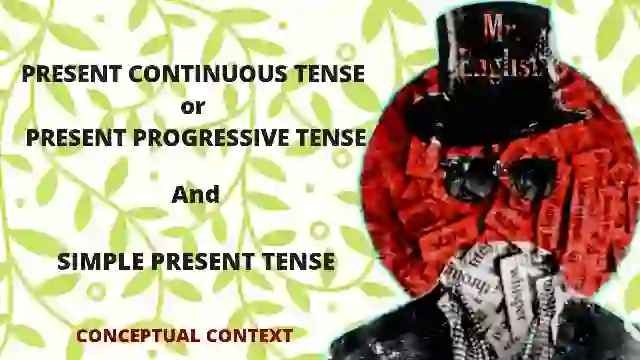
Present Continuous
Present Continuous is also an important Tense in English. We also call it “Present Progressive.” The definition of it itself is the name. The explanation is below.
KJ – What is the definition of Present Continuous?
Mr English – The definition is based on its name Present Continuous. A time that is just happening right now.
KJ – Wrong! The definition is based on its name Present Continuous. A time that is present but continuous (progressive). Progress does not mean that something is just happening right now. The name of the definition shows only continuity that can place any time. It means that the progress is still going on and has not stopped yet, so It can be Present and Future.
KJ – CONFUSED? TAKE A LOOK BELOW TO UNDERSTAND IT CLEARLY!
Present Continuous = Any work, event, action, or activity that is happening at or around the time of speaking, we call it Present Continuous Tense.
Present Continuous Rules
Is + verb 1st form + ing = He, she, it, this, that, singular noun…
Am + verb 1st form + ing = I
Are + verb 1st form + ing = You, we, they, these, those, plural nouns…
Present Continuous Format
Affirmative = Subject + is/am/are + verb 1st form + ing + other words.
Negative = Subject + is/am/are + not + verb 1st form + ing + other words.
Is/Am/Are + Not = Isn’t/Amn’t/Aren’t
We can also use “Ain’t” in place of all these three “Isn’t/Amn’t/Aren’t.”
Simple Interro = Is/am/are + subject + verb 1st form + ing + other words?
Simple Interro Negative = Is/am/are + subject + not + verb 1st form + ing + other words?
Interrogative = Wh-family + is/am/are + subject + verb 1st form + ing + other words?
Interrogative Negative = Wh-family + is/am/are + subject + not + verb 1st form + ing + other words?
Definition
1. Event and Action at the time of speaking – When any action or event is happening at the time of making or speaking a sentence by a speaker or a first-person, we call it Present Continuous
Suppose, I am talking and I make a sentence that “I am speaking.” This is an action at the time of speaking.
e.g. –
- He is writing a letter. (I am speaking a sentence and at the time ‘He is writing a letter.’)
- I am playing a game. (I am speaking a sentence and at the time ‘I am playing a game.’)
- Are you driving? (I am asking a question and at the time ‘Someone is or is not driving.’)
- We ain’t playing right now. (I am speaking a sentence and at the time ‘We are not playing.’) (It is easy to detect “Are” from “Ain’t” because we use “Are” with the plural “We.”)
- She ain’t looking me when I am talking to her. (I am speaking a sentence and at the time ‘She is not looking me.’) (It is easy to detect “Is” from “Ain’t” because we use “Is” with the singular “She.”)
2. Event and Action around the time of speaking – When any action or event is not happening exactly now, but that happens just before or after now; which means around the time of making or speaking a sentence by a speaker or a first-person, we call it Present Continuous.
Suppose, “I am playing a game on the computer.” I get a call from my sister. I go out of my room to take the phone call.
My Sister = She asks, “What are you doing?”
I make a sentence that “I am playing a game on the computer.”
Question = Am I really playing the game right now?
No!
But still, this sentence is correct because I did not actually stop playing, the progress is not over. It is on hold, but not stop. This is the progress that is happening around the time of speaking or making the sentence. When I finish talking to my sister, I go back to my room and start playing again.
e.g. –
- Who is taking care of the patients while you are here? ( You are here. You already leave the patients and reach the place where a person asks, “Who is taking care of the patients while you are here?’ The progress of taking care is on hold, but does not stop.)
- They are doing cheat in the exam since when the exam starts. (From the beginning to end, they are cheating. The progress of cheating stops for a while, but they continue it again.)
3. Repeated or Unplanned Temporary Action and Event – Any repeated or unplanned action or event that is happening temporarily, again and again, is called Present Continuous. This repeated or unplanned action or event is not our daily routine.
Some common phrase comes with it – at the movement, nowadays, recently, these days, in (these) few days, in a couple of days, currently, at present, constantly, etc.
e.g. –
- He is eating a lot at the movement. (Eating a lot now, not always)
- I am getting too much angry these days. (Getting angry these days but not always.)
- Raj and Sam are spending way too much on vegetables nowadays. (temporary or unplanned, not permanent)
- They are currently jogging a lot. (temporary or unplanned, not permanent)
- She is constantly crying. (temporary or unplanned, not permanent)
(Definition 2 and Definition 3 are kind of the same. )
Present Continuous + Always = When a progress is always going on, it means “The progressive action or event is happening ‘too much/too often’,” and it annoys the speaker, we call that sentence Present Continuous + Always.
e.g. –
- Jack is always talking too loud. (Jack does it all the time and it annoys a lot.)
- They are always cursing everyone. (They do it all the time and it annoys a lot.)
- He is always playing that stupid video game. (He does it all the time and it annoys a lot.)
4. Plans or Arrangement – When we already prepared any plan or arrangement for the future, we can use Present Continuous. It is a pre-planned future, but it also denotes that the progress is going from the present to the future.
e.g. –
- We are moving from this apartment to a new apartment this month. (pre-planned present to future)
- What are you doing next week? (ask for a pre-planned present to future)
- He is starting to learn English tomorrow. (pre-planned present to future)
- She is supplying food there 3 days after tomorrow. (pre-planned present to future)
- Are you still playing golf next Saturday? (ask for a pre-planned present to future)
- I am going to Goa for a trip within the next 2 weeks. (pre-planned present to future)
[su_button url=”https://mrenglishkj.com/present-continuous-exercise/” target=”blank” style=”3d” background=”#19d72f” size=”10″]Present Continuous Tense Exercise[/su_button]
Advice – Never learn any language from a different language. You should learn English in English, not in your native language (mother-tongue). Just like you learned your mother tongue in your own mother tongue. By learning in this way makes your English accurate, fluent, and you learn it quickly.
Thanks for choosing us.



